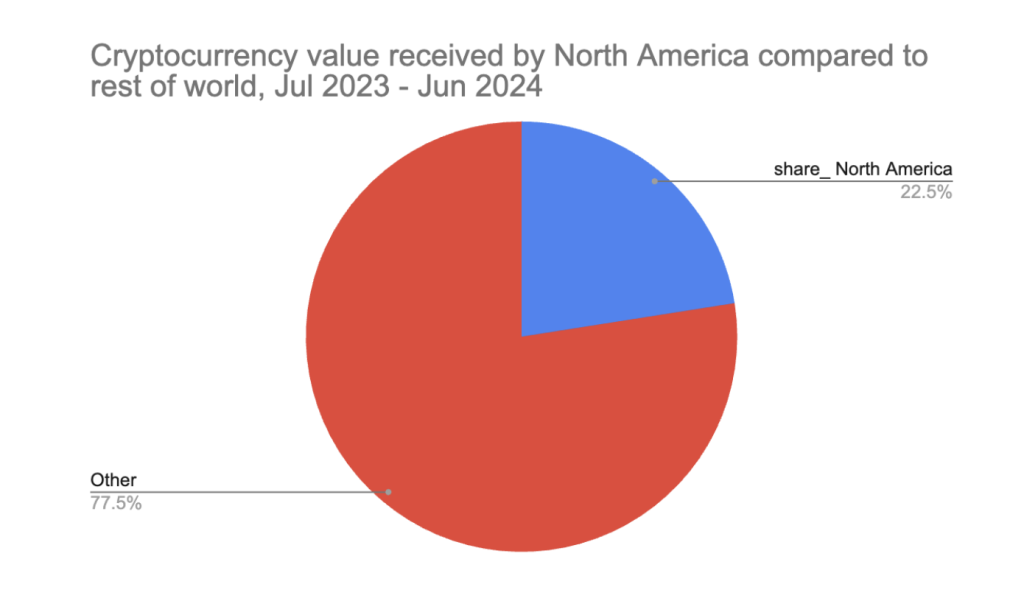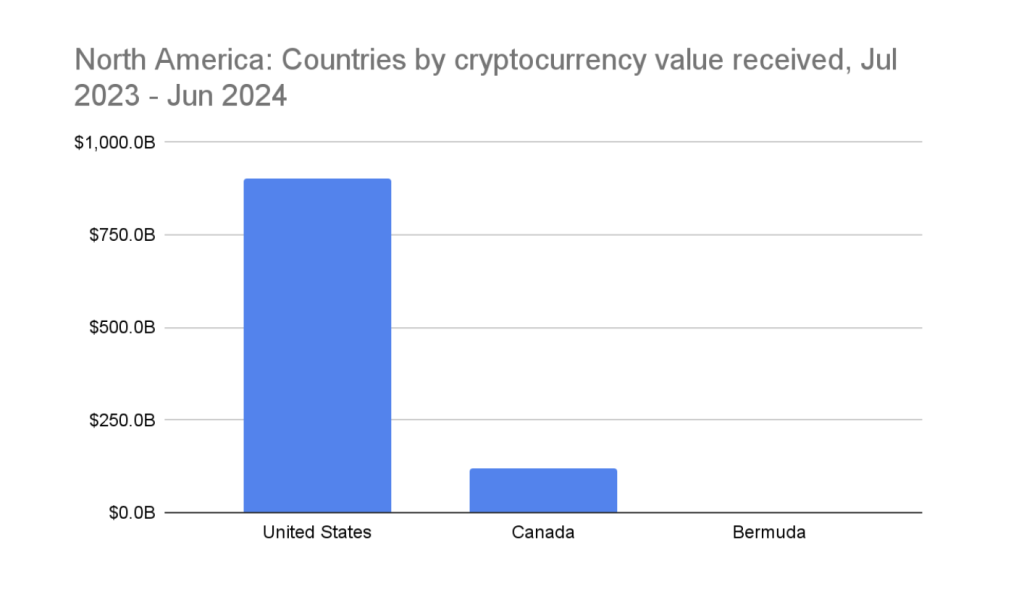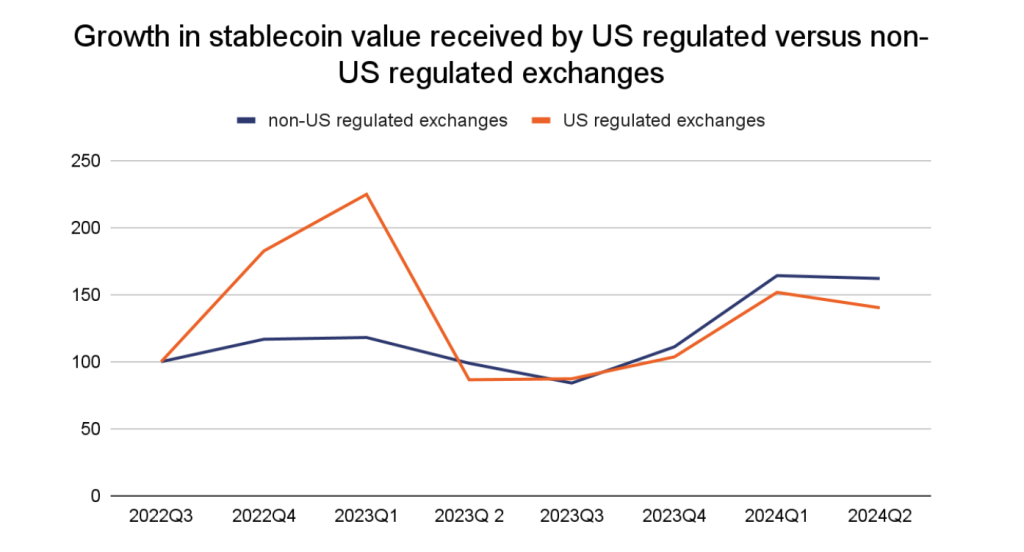Chainalysis Report: North America Dominates Crypto Market Due To Institutional Activity

A new report from blockchain analysis firm Chainalysis shows that North America remains the largest cryptocurrency market in the world.
According to the report, North America saw an estimated $1.3 trillion in on-chain value received between July 2023 and June 2024. This represents about 22.5% of global activity.

Institutional Interest Remains High
Eric Jardine, Cybercrime Research Lead at Chainalysis, told Cryptonews that institutional activity is largely driving North America’s crypto market dominance.
“The biggest catalyst for the rise of institutional crypto activity in North America is the Securities and Exchange Commission’s approval of spot Bitcoin exchange-traded funds (ETFs) in January of 2024,” Jardine said. “These financial instruments have been extraordinarily successful, opening new markets and pools of liquidity in North America and across the globe.”
This appears to be the case. On October 14, Spot Bitcoin ETFs in the US saw their biggest one-day inflow in over four months. Over a billion dollars in inflows were seen across the 11 ETF offerings.
Chainalysis’s report also mentions that the Canadian market remains a key player in North America, receiving approximately $119 billion in value between July 2023 and June 2024.

Overall, 70% of North America’s crypto activity was transfers exceeding $1 million.
Why Institutional Activity Is Increasing
David Duong, Head of Institutional Research at Coinbase, told Cryptonews that the institutional trading volume on the exchange’s platform more than doubled during the first half of 2024.
Duong believes this increase is due to the US regulatory environment gaining clarity following the court decisions in last year’s Ripple and Grayscale cases.
“These cases cleared the path for large asset managers like BlackRock and Fidelity to launch US spot BTC and ETH ETFs,” Doung said.
He added that Bitcoin ETFs have been one of the most successful ETF launches on record. According to Bloomberg, BTC ETFs ranked among the top 0.1% over the last 30 years.
“This has attracted an increase in liquidity and market depth to the asset class, which are critical factors for institutional involvement,” Doung remarked.
Doung further pointed out that the infrastructure available for institutions to trade crypto in the US has matured. Indeed, more platforms have begun offering institutional-grade custody, financing solutions, and advanced trading tools.
Additionally, Doung noted that large asset management portfolios may likely be overloaded on other asset classes, like private equity and credit.
“We believe that investor concerns surrounding an approaching credit ‘maturity wall’ in early 2025 could increase excess demand for alternatives like cryptocurrencies as a means of diversifying the concentration of credit risk in their existing portfolios,” he said.
Will The 2024 US Presidential Election Impact The Crypto Market?
While it’s notable that North America continues to lead global crypto adoption, the upcoming US presidential election will likely have an impact.
“In the short term, we expect the US elections to be the next major market catalyst for nearly all assets – both traditional and digital,” Doung said.
Yet Doung predicts that the crypto market will remain neutral or positive following the election.
“But if there is any knee-jerk sell-off after the event, we expect that to be met with institutional support because of the clear upside for the asset class,” he said.
Jardine believes that clarity after the 2024 presidential election will allow for new crypto development, investment, and innovation.
Challenges Facing North America’s Crypto Dominance
Although North America leads the global crypto market, Jardine pointed out that retail adoption is not as large as institutional activity in the region.
“One interesting thing of note thus far into 2024 is that retail (small, large and even professional sized transfer activity) is not yet fully participating in the resurgence of North America’s crypto ecosystem, as seen in the growth index chart,” he said. “In other words, the current retail crypto environment within the US is not yet back to its previous bull market levels.”
Charles Adkins, President of the decentralized, open-source public ledger Hedera, told Cryptonews that he believes the primary challenge North America will face moving forward will be regulatory.
“Crypto regulatory frameworks are developing in Europe, Asia and the Middle East, attracting businesses that want to adhere to clear legal frameworks,” Adkins said. “Developing clear rules in the US will be critical to maintaining North American leadership in the crypto sector.”
This will likely be the case. For instance, Europe has implemented regulatory frameworks like The Markets in Crypto-Assets Regulation (MiCA), which took effect this year.
It was also recently announced that The Central Bank of the United Arab Emirates (CBUAE) granted approval to an AED-backed Stablecoin. The firm is the first issuer of a fully regulated dirham-pegged stablecoin in the region (UAE).
North America Requires Clear Regulatory Crypto Frameworks
Given the advancing regulatory landscape of cryptocurrency outside North America, industry experts believe that this will become mandatory for the region to continue to thrive.
“Everything boils down to sensible regulation with clear rules,” said Hadley Stern, Chief Commercial Officer at Solana staking platform Marinade.
Stern told Cryptonews that the talent and passion for crypto are in North America. Still, the inability to take risks to find product market fit has unfortunately shifted outside the US.
Duong added that the US has not yet reached a consensus on stablecoin supervision.
“This has allowed the share of stablecoin activity outside of North America to grow,” he remarked. “Liquidity in the crypto ecosystem tends to be reflected within stablecoin dynamics, as many centralized and decentralized exchanges alike price their assets in USD stablecoins.”

Given this, Duong commented that the risk of lower stablecoin adoption in North America could result in a reduction in liquidity, along with decline in trading activity.
The post Chainalysis Report: North America Dominates Crypto Market Due To Institutional Activity appeared first on Cryptonews.
Read More

Coinbase CEO’s Bold Prediction: Bitcoin Set to Replace Dollar as Reserve Currency Amid $36.2T Debt Crisis
Chainalysis Report: North America Dominates Crypto Market Due To Institutional Activity

A new report from blockchain analysis firm Chainalysis shows that North America remains the largest cryptocurrency market in the world.
According to the report, North America saw an estimated $1.3 trillion in on-chain value received between July 2023 and June 2024. This represents about 22.5% of global activity.

Institutional Interest Remains High
Eric Jardine, Cybercrime Research Lead at Chainalysis, told Cryptonews that institutional activity is largely driving North America’s crypto market dominance.
“The biggest catalyst for the rise of institutional crypto activity in North America is the Securities and Exchange Commission’s approval of spot Bitcoin exchange-traded funds (ETFs) in January of 2024,” Jardine said. “These financial instruments have been extraordinarily successful, opening new markets and pools of liquidity in North America and across the globe.”
This appears to be the case. On October 14, Spot Bitcoin ETFs in the US saw their biggest one-day inflow in over four months. Over a billion dollars in inflows were seen across the 11 ETF offerings.
Chainalysis’s report also mentions that the Canadian market remains a key player in North America, receiving approximately $119 billion in value between July 2023 and June 2024.

Overall, 70% of North America’s crypto activity was transfers exceeding $1 million.
Why Institutional Activity Is Increasing
David Duong, Head of Institutional Research at Coinbase, told Cryptonews that the institutional trading volume on the exchange’s platform more than doubled during the first half of 2024.
Duong believes this increase is due to the US regulatory environment gaining clarity following the court decisions in last year’s Ripple and Grayscale cases.
“These cases cleared the path for large asset managers like BlackRock and Fidelity to launch US spot BTC and ETH ETFs,” Doung said.
He added that Bitcoin ETFs have been one of the most successful ETF launches on record. According to Bloomberg, BTC ETFs ranked among the top 0.1% over the last 30 years.
“This has attracted an increase in liquidity and market depth to the asset class, which are critical factors for institutional involvement,” Doung remarked.
Doung further pointed out that the infrastructure available for institutions to trade crypto in the US has matured. Indeed, more platforms have begun offering institutional-grade custody, financing solutions, and advanced trading tools.
Additionally, Doung noted that large asset management portfolios may likely be overloaded on other asset classes, like private equity and credit.
“We believe that investor concerns surrounding an approaching credit ‘maturity wall’ in early 2025 could increase excess demand for alternatives like cryptocurrencies as a means of diversifying the concentration of credit risk in their existing portfolios,” he said.
Will The 2024 US Presidential Election Impact The Crypto Market?
While it’s notable that North America continues to lead global crypto adoption, the upcoming US presidential election will likely have an impact.
“In the short term, we expect the US elections to be the next major market catalyst for nearly all assets – both traditional and digital,” Doung said.
Yet Doung predicts that the crypto market will remain neutral or positive following the election.
“But if there is any knee-jerk sell-off after the event, we expect that to be met with institutional support because of the clear upside for the asset class,” he said.
Jardine believes that clarity after the 2024 presidential election will allow for new crypto development, investment, and innovation.
Challenges Facing North America’s Crypto Dominance
Although North America leads the global crypto market, Jardine pointed out that retail adoption is not as large as institutional activity in the region.
“One interesting thing of note thus far into 2024 is that retail (small, large and even professional sized transfer activity) is not yet fully participating in the resurgence of North America’s crypto ecosystem, as seen in the growth index chart,” he said. “In other words, the current retail crypto environment within the US is not yet back to its previous bull market levels.”
Charles Adkins, President of the decentralized, open-source public ledger Hedera, told Cryptonews that he believes the primary challenge North America will face moving forward will be regulatory.
“Crypto regulatory frameworks are developing in Europe, Asia and the Middle East, attracting businesses that want to adhere to clear legal frameworks,” Adkins said. “Developing clear rules in the US will be critical to maintaining North American leadership in the crypto sector.”
This will likely be the case. For instance, Europe has implemented regulatory frameworks like The Markets in Crypto-Assets Regulation (MiCA), which took effect this year.
It was also recently announced that The Central Bank of the United Arab Emirates (CBUAE) granted approval to an AED-backed Stablecoin. The firm is the first issuer of a fully regulated dirham-pegged stablecoin in the region (UAE).
North America Requires Clear Regulatory Crypto Frameworks
Given the advancing regulatory landscape of cryptocurrency outside North America, industry experts believe that this will become mandatory for the region to continue to thrive.
“Everything boils down to sensible regulation with clear rules,” said Hadley Stern, Chief Commercial Officer at Solana staking platform Marinade.
Stern told Cryptonews that the talent and passion for crypto are in North America. Still, the inability to take risks to find product market fit has unfortunately shifted outside the US.
Duong added that the US has not yet reached a consensus on stablecoin supervision.
“This has allowed the share of stablecoin activity outside of North America to grow,” he remarked. “Liquidity in the crypto ecosystem tends to be reflected within stablecoin dynamics, as many centralized and decentralized exchanges alike price their assets in USD stablecoins.”

Given this, Duong commented that the risk of lower stablecoin adoption in North America could result in a reduction in liquidity, along with decline in trading activity.
The post Chainalysis Report: North America Dominates Crypto Market Due To Institutional Activity appeared first on Cryptonews.
Read More

